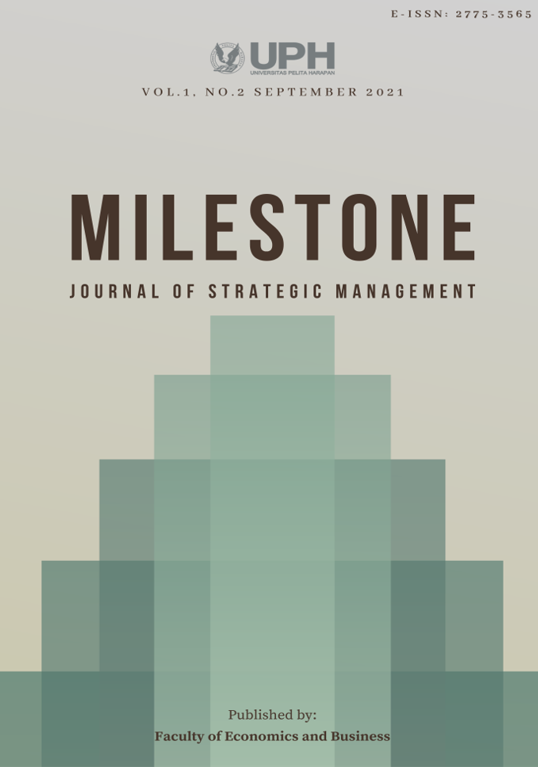Hospital's ReDOWSKo Application Forms and Influence in Action
DOI:
https://doi.org/10.19166/ms.v1i2.4209Λέξεις-κλειδιά:
ReDOWSKo, health application, hospital accreditation, accreditation instrument, accreditation surveyΠερίληψη
The rise of the current digital era brought by further sophisticated technology increases access to global information and advancement in various industry application. In 2012, Hospital Accreditation Commission KARS launched an application to assist hospitals in accreditation assessment. Due to the lack of understanding and perception of accreditation standards, improvements were made to develop new standards using a methodology called ReDOWSKo. This study will look into measuring the use between ReDOWSKo application and book form. Data was collected using google form questionnaire and analyzed using descriptive statistic and correlation method. The results show there is a relationship between the ReDOWSKo assessment in the form book and application with the nature of weak and unidirectional relationships. In this case the application is used to help remember important elements in accreditation. There is also correlation that is statistically significant between application users and book users and there is a positive relationship between the use of ReDOWSKo book form with application form. This application relatively new, and have little literature found while the use of the ReDOWSKo application is indeed considered not yet optimal. This study suggest it would require time for adoption of the use of the application that could enhance the effectiveness of ReDOWSKo. Therefore, will include upgrading the application and further socialization and training in the upcoming years.
Αναφορές
Alexander, J. C. (2004). Cultural pragmatics: Social performance between ritual and strategy. Sociological Theory, 22(4), 527-573. https://doi.org/10.1111/j.0735-2751.2004.00233.x
Araújo, L. V., Letti, B. C., Cantagalli, F. T., Silva, G. S., Ehlert, P. P., & Araújo, L. M. Q. (2015). "A Health Mobile Application and Architecture to Support and Automate In-home Consultation," 2015 IEEE 28th International Symposium on Computer-Based Medical Systems, pp. 151-156. https://doi.org/10.1109/CBMS.2015.66
Bruns, K., & Jacob, K. (2014). Value-in-use and mobile technologies: A general approach for value-in-use measurement and a specific application based on smartphone usage. Business and Information Systems Engineering, 6(6), 349-359. https://doi.org/10.1007/s12599-014-0349-x
Chan-Olmsted, S. M., & Chang, B.-H. (2006). Audience knowledge, perceptions and factors affecting the adoption intent of terrestrial digital television. New Media & Society, 8(5), 773-800. https://doi.org/10.1177/1461444806067588
Ding, Y., & Chai, K. H. (2015). Emotions and continued usage of mobile applications. Industrial Management and Data Systems, 115(5), 833-852. https://doi.org/10.1108/IMDS-11-2014-0338
Ferreira, D., Goncalves, J., Kostakos, V., Barkhuus, L., & Dey, A. K. (2014). "Contextual experience sampling of mobile application micro-usage," MobileHCI 2014 - Proceedings of the 16th ACM International Conference on Human-Computer Interaction with Mobile Devices and Services, pp. 91-100. https://doi.org/10.1145/2628363.2628367
Gouin-Vallerand, C., & Mezghani, N. (2014). "An analysis of the transitions between mobile application usages based on Markov chains," UbiComp 2014 - Adjunct Proceedings of the 2014 ACM International Joint Conference on Pervasive and Ubiquitous Computing, pp. 373-378. https://doi.org/10.1145/2638728.2641700
Hidayat, E., Lukman, Noprisson, H., Sensuse, D. I., Sucahyo, Y. G., & E. D. Putra. (2016). "Development of mobile application for documenting traditional knowledge in Indonesia," 2016 IEEE Student Conference on Research and Development (SCOReD), 2016, pp. 1-5. https://doi.org/10.1109/SCORED.2016.7810043
Hwang, K., Chan-Olmsted, S. M., Nam, S. -H., & Chang B., -H. (2016). Factors affecting mobile application usage: Exploring the roles of gender, age, and application types from behaviour log data. International Journal of Mobile Communications, 14(3), 256-272. https://doi.org/10.1504/IJMC.2016.076285
Kim, W. J., Kim, I. K., Jeon, M. K., & Kim, J. (2016) "UX Design Guideline for Health Mobile Application to Improve Accessibility for the Visually Impaired," 2016 International Conference on Platform Technology and Service (PlatCon), pp. 1-5. https://doi.org/10.1109/PlatCon.2016.7456838
Larivière, B., Joosten, H., Malthouse, E. C., van Birgelen, M., Aksoy, P., Kunz, W. H., & Huang, M., -H (2013). Value fusion: The blending of consumer and firm value in the distinct context of mobile technologies and social media. Journal of Service Management, 24(3), 268-293. https://doi.org/10.1108/09564231311326996
Lind, D. A., Marchal, W. G., & Wathen, S. A. (2018). Statistical techniques in business and economics. McGraw Hill.
Peddi, S. V. B., Yassine, A., & Shirmohammadi, S. (2015). "Cloud based virtualization for a calorie measurement e-health mobile application," 2015 IEEE International Conference on Multimedia & Expo Workshops (ICMEW), pp. 1-6, https://doi.org/10.1109/ICMEW.2015.7169853
Venkatesh, V., Thong, J. Y. L., & Xu, X. (2012). Consumer acceptance and use of information technology: Extending the unified theory of acceptance and use of technology. MIS Quarterly, 36(1), 157-178. https://doi.org/10.2307/41410412
Voss, K. E., Spangenberg, E. R., & Grohmann, B. (2003). Measuring the hedonic and utilitarian dimensions of consumer attitude. Journal of Marketing Research, 40(3), 310-320. https://doi.org/10.1509/jmkr.40.3.310.19238
Yoo, Y. (2010). Computing in everyday life: A call for research on experiential computing. MIS Quarterly, 34(2), 213-231. https://doi.org/10.2307/20721425
Λήψεις
Δημοσιευμένα
Τεύχος
Ενότητα
Άδεια
Authors who publish with this journal agree to the following terms:
1) Authors retain copyright and grant the journal right of first publication with the work simultaneously licensed under a Creative Commons Attribution License (CC-BY-SA 4.0) that allows others to share the work with an acknowledgement of the work's authorship and initial publication in this journal.
2) Authors are able to enter into separate, additional contractual arrangements for the non-exclusive distribution of the journal's published version of the work (e.g., post it to an institutional repository or publish it in a book), with an acknowledgement of its initial publication in this journal.
3) Authors are permitted and encouraged to post their work online (e.g., in institutional repositories or on their website). The final published PDF should be used and bibliographic details that credit the publication in this journal should be included.





